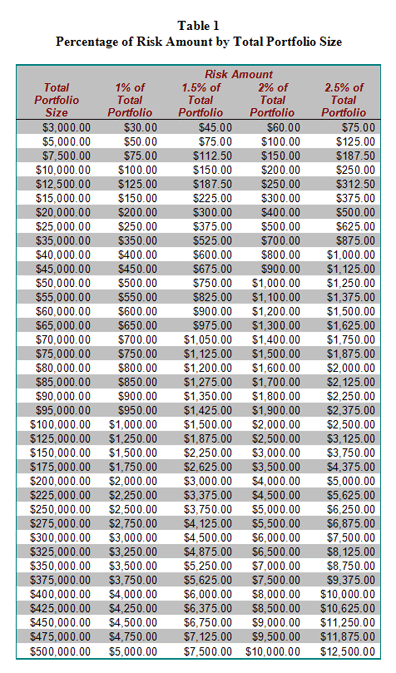Risk Management
Position Sizing Primer
SPONSOR:
The trend is your friend! Click here to see the Top 50 Trending Stocks.

The risk management position sizing primer is about two aspects of risk management: What is your risk profile or comfort level with risk and exactly how much are you willing to lose on a trade before you exit the position so to limit loss?
Unfortunately, not all trades are winners. Different kinds of investments lose money, and stock investing is no different. One of the benefits of stock market investing is that you can decide your bottom line ahead of time and get out of a losing position easily.
In this risk management position sizing primer, the very first thing to do is to decide on a level of risk that fits your personality. Below is a list of risk profiles and the appropriate percentage of risk for that profile.
Risk Management
Risk Level/Profile
Conservative 1-1.5%
Mid-Range 1.5%-2.0%
Aggressive 2.0%-2.5%
In Table 1 below, you can see the total portfolio sizes with the varying percentage of risk amounts to use per stock market position. The Total Portfolio Size starts at $3,000 because it’s really the minimum amount one should begin investing with to avoid taking on too much risk. If you don’t have $3,000 to start, begin with an investment savings account and save whatever you can on a weekly or monthly basis until you reach the $3,000 mark.

Keep in mind, risk is not the total amount you’ll put in one stock market investment. Risk is what you’re willing to lose in the position if the trade goes against you.
What you’re doing here is using your total portfolio size to calculate how much you’d be willing to lose in any one position. After you decide on your risk profile percentage, an easy way to see how this all fits together is to use Table 1 and fill in the following blanks:
My total portfolio is: $
My risk level/profile is: % of my portfolio on each investment position
That risk amount is: $
Risk Management Position Sizing Primer Example 1
My total portfolio is: $10,000
I will risk a maximum of: 1% of my portfolio on each investment position
That risk amount is: $100
Risk Management Position Sizing Primer Example 2
My total portfolio is: $75,000
I will risk a maximum of: 1.5% of my portfolio on each investment position
That risk amount is: $1,125
Risk Management Position Sizing Primer Example 3
My total portfolio is: $100,000
I will risk a maximum of: 2.5% of my portfolio on each investment position
That risk amount is: $2,500
This risk strategy works because if you have five losses in a row you will still have 87.5%-95% of your capital to reinvest. (Note: If you have five or more losses in a row stop trading and reassess
Stock Market System Steps 1-3.
)
One other thing to consider is to include the commission costs in the total risk amount for each position.
Commission costs
are a reality that can eat away at smaller portfolios especially if the investor is trading frequently. The trick for smaller portfolios is to trade less and find a deep discount online brokerage like . Two $10 round trip trades a month is $20 and yearly that’s $240. If you have a $3,000 portfolio, $240 in commission fees is 8% of your portfolio in a year. This means your portfolio has to gain 8% in a year just to break even! For a $10,000 portfolio, the commission expense is 2.4%. Unfortunately, this is the realty, so folding the commission fees into the risk figure will benefit your bottom line. Just take the round trip commission fee off the top of the risk amount. For $10,000, the 1% total risk amount is $100. You would simply change the risk amount to $90.
If you don’t like the idea of a loss, think of the risk amount as the size of a donation, an insurance policy or a stock investing course. Losses are part of investing and sooner they’re taken in stride, the better. Also, remember that right now, here you are learning how to understand and minimize losses – all of which will empower you.
Action Step: Pick the percentage risk level/profile that you’re comfortable with and calculate how much you’re willing to lose on any one trade.
Understanding potential loss amounts is an important piece to stock investing success, but this discussion still hasn’t given you the piece that you need to complete your position sizing which is how much of your portfolio do you invest in any position? So far, you’ve only identified the important piece of how much you’re willing to lose. Part of the position sizing problem is that not all stocks are the same. There are different price points and some stocks have prices that move around – a lot. The next step is adjusting your position size to account for this part of risk and allow the price of the investment to move freely.
The basics of managing risk using position sizing is discussed on the webpage,
position sizing (link). But if you’re ready to position size like the pros go to
Stock Market Portfolio Position Sizing.
Return to
Stock Trading Systems
for the next step in creating a system that works.
Return from
Risk Management Position Sizing Primer to Online Stock Trading Warrior Home.
Want to Know If Your Stock's In a Trend?









